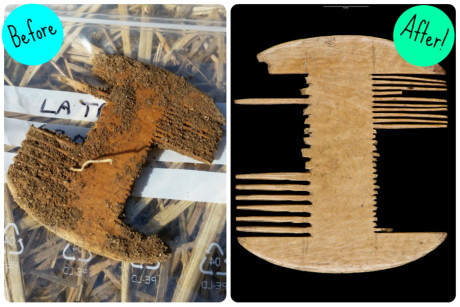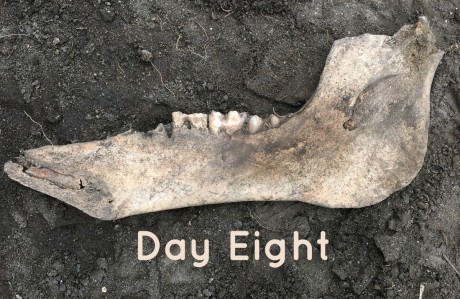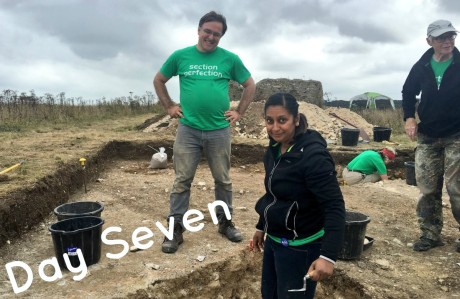
Sara Brown, Archaeological Conservator
This bone comb had a bit of a shock to the system when it was suddenly pulled out of the dark, damp, depths of trench 9 that it had been sitting in for centuries.
For a while it was touch and go; the field team had to work hard to make sure it didn’t dry out before it could be transferred to the conservation lab, where its condition could finally be stabilised.
Bone is pretty porous, so if it’s not handled properly and allowed to dry out without proper control, it could warp, crack or even fragment. For valuable archaeological evidence like this, that’s a serious risk.
Condition on arrival
Thankfully, the DigVentures crew had done an excellent job of ensuring that the comb was kept damp and had not been allowed to dry out and the comb was still waterlogged when it arrived at the conservation lab.
But there was also soil compacted in and around the remaining teeth. The iron rich soil had also left an orange patina on the comb’s surface, and under a microscopic examination, it was showing early signs of delamination. There was also a substantial fracture across the body, but judging by the fact that there was soil deeply embedded in it, it was clear that this crack had appeared long before the comb came out of the ground.
Stabilising the artefact’s condition
So the comb now needed to be stabilised and got ready for long-term storage. This involved implementing a controlled drying so that the bone was stable in ambient temperatures. Bone is a very porous material, and if dried too quickly the structure of the bone could be completely destroyed.
With waterlogged material the most difficult aspect of treatment is usually ensuring a slow and controlled drying process.
The actual drying process took a number of weeks. This required slowly decreasing the humidity of the environment in which the bone was kept in until it was adjusted to a ‘normal’ environment (ambient relative humidity and temperatures).
Getting scrubbed up
Once the drying process had been completed I removed the soil that was stuck to the comb’s surface and between its teeth. This work was completed under a microscope using soft tools so as not to damage the soft surface of the bone, but even so, the bench time to do this was actually pretty quick.
Handle with care
Thankfully this went very smoothly and I’m pleased to say that the comb is now clean and stable and should not require any future treatment, but from now on, it will need to be handled with care and kept at a steady temperature (22 degrees) and constant humidity (45-65% relative humidity).


